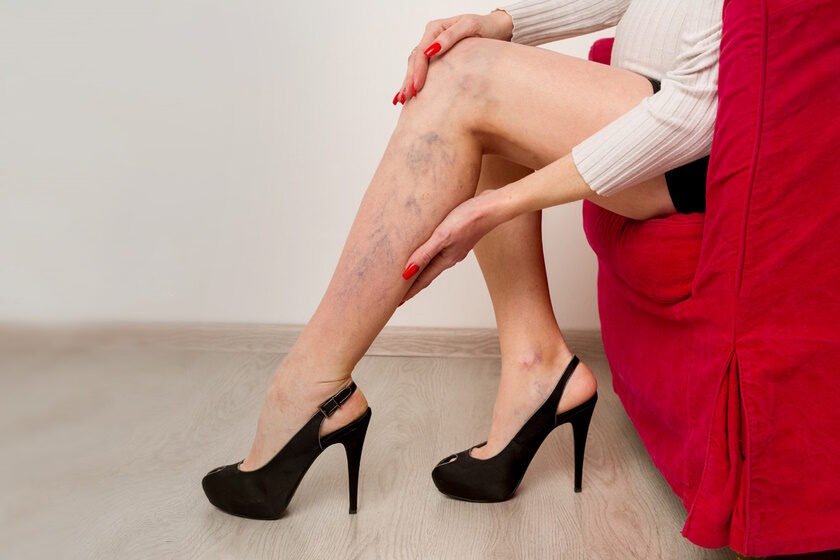
The Link Between Varicose Veins and Deep Vein Thrombosis (DVT)
Varicose veins and deep vein thrombosis (DVT) are both conditions that affect the veins in the body. While they may seem different, there is a often link between the two. In this article, Dr Sumit Kapadia a renowned Senior Vascular Surgeon will explore and explain the link between varicose veins and DVT, what each condition is, and how they differ.
Varicose veins and deep vein thrombosis (DVT) are two vascular conditions that are commonly associated with each other. Varicose veins are a common condition that affects millions of people worldwide, while DVT is a more serious condition that can lead to life-threatening complications. Understanding the link between varicose veins and DVT is essential for the prevention and treatment of these conditions.
What is Deep Vein Thrombosis (DVT)?
Deep vein thrombosis (DVT) is a condition where a blood clot forms in one of the deep veins in the body. This most commonly occurs in the legs, but it can also occur in the arms or other parts of the body. DVT can cause pain, swelling, and redness in the affected area. In some cases, a blood clot can break off and travel through the bloodstream, causing a potentially life-threatening condition called a pulmonary embolism (PE). DVT can have serious consequences if left untreated. The blood clots can break loose and travel through the bloodstream to the lungs, causing a condition called pulmonary embolism (PE). PE can be fatal if not treated promptly. DVT can also cause long-term complications, such as chronic swelling, pain and ulcers in the affected limb ( Post thrombotic Syndrome)
There are several risk factors for DVT, including prolonged periods of sitting or lying down, such as during long plane flights or hospital stays for trauma, surgery or medical illnesses. Other risk factors include obesity, pregnancy, smoking, and certain medical conditions, such as cancer or a previous DVT.
Also read: Veins vs. Arteries: What’s the Difference?
What are Varicose Veins?
Varicose veins are enlarged, twisted veins that appear blue or purple in color. They are most commonly found in the legs, but can occur in other parts of the body as well. Varicose veins occur when the valves in the veins do not function properly, causing the blood to pool and the veins to become enlarged.
Varicose veins are a common condition, affecting up to 23% of adults worldwide. The condition is more common in women than in men and is more prevalent in older individuals.
DVT Vs Varicose Veins
While both DVT and varicose veins are vascular conditions that affect the veins in the legs, there are some key differences between the two conditions. Varicose veins are a cosmetic concern for most people, while DVT is a more serious medical condition that requires immediate treatment.
Varicose veins are usually not life-threatening, but they can cause discomfort and pain, especially when standing for long periods of time. In some cases, varicose veins can also cause skin ulcers and bleeding.
On the other hand, DVT is a serious condition that can lead to life-threatening complications if left untreated. The blood clots that form in the deep veins can break loose and travel to the lungs, causing a pulmonary embolism. PE can be fatal if not treated immediately.
Another difference is that varicose veins are a result of weakened valves in the veins, while DVT is caused by a blood clot forming in one of the deep veins. While varicose veins can be uncomfortable and cause pain, they do not typically lead to serious health problems.
However, there is a link between varicose veins and DVT. People with varicose veins are at a higher risk of developing DVT. This is because the weakened valves in the veins can lead to blood pooling, which can increase the risk of a blood clot forming.
Additionally, people with varicose veins may be more likely to experience symptoms of DVT, such as pain and swelling in the legs. This is because the enlarged veins can put pressure on the surrounding tissues, causing discomfort.
The other aspect is that following recovery from DVT, patients can develop varicose veins, called as secondary varicose veins.
The link between Varicose Veins and DVT
While varicose veins and DVT are two distinct conditions, there is a link between the two. Varicose veins are a risk factor for DVT, as they can slow down the blood flow in the veins and increase the risk of blood clots forming.
When the valves in the veins do not function properly, the blood can pool in the veins, causing the veins to become enlarged and twisted. This can lead to a condition called venous insufficiency, which is a risk factor for DVT.
The risk of DVT is also increased in individuals who have had a history of varicose veins or have a family history of the condition. Other risk factors for DVT include obesity, smoking, pregnancy, and immobility.
Also Read: Are Varicose Veins hereditary?
Prevention and Treatment for DVT and Variocse Veins
Prevention and treatment for DVT and varicose veins differ. Preventing DVT involves reducing the risk factors, such as avoiding prolonged periods of sitting, maintaining a healthy weight, and quitting smoking. People who are at a higher risk of DVT, such as those who have had a previous DVT or who have a medical condition that increases their risk, may need to take blood-thinning medication to prevent clots from forming.
Treatment for DVT typically involves blood-thinning medication and compression stockings to improve blood flow in the affected area. In severe cases, surgery or minimally invasive methods ( Catheter directed thrombolysis or angiojet thrombectomy) may be necessary to remove the blood clot.
Treatment for varicose veins may involve lifestyle changes, such as exercise and weight loss, as well as compression stockings to reduce the size of the veins. In some cases, surgery may be necessary to remove the affected veins.
Preventing DVT in individuals with varicose veins
Preventing DVT in individuals with varicose veins is essential to reduce the risk of life-threatening complications. There are several strategies that can help prevent DVT in individuals with varicose veins.
One of the most effective strategies is to maintain a healthy weight and engage in regular physical activity. Exercise can improve the blood flow in the veins and reduce the risk of blood clots forming.
Final Words
In conclusion, varicose veins and deep vein thrombosis (DVT) are two conditions that affect the veins in the body. While they are different in their causes and symptoms, there is a link between the two. People with varicose veins are at a higher risk of developing DVT, and may also experience symptoms of DVT, such as pain and swelling in the legs.
Prevention and treatment for DVT and varicose veins differ, but both can involve lifestyle changes and medical interventions. Preventing DVT involves reducing the risk factors, such as avoiding prolonged periods of sitting, while treating DVT typically involves blood-thinning medication and compression stockings.
Treatment for varicose veins may involve lifestyle changes and compression stockings, but in some cases, surgery may be necessary. It’s important to consult a healthcare provider if you are experiencing symptoms of either condition, as prompt diagnosis and treatment can help prevent serious complications.
It’s also important to be aware of the link between varicose veins and DVT, especially if you have a family history of either condition or are at risk for DVT. Managing varicose veins and reducing risk factors for DVT can help reduce the likelihood of developing DVT and prevent serious complications.
Follow us on YouTube

MBBS, MS, MRCS, DNB-Fellow
Dr. Sumit Kapadia
Dr. Sumit Kapadia / MR KAPADIA SUMIT a gold-medalist from Baroda Medical College, obtained his general surgical training and senior residency from SSG Hospital, Vadodara.

MBBS, MS, MRCS, DNB-Fellow
Dr. Sumit Kapadia
Dr. Sumit Kapadia / MR KAPADIA SUMIT a gold-medalist from Baroda Medical College, obtained his general surgical training and senior residency from SSG Hospital, Vadodara.




